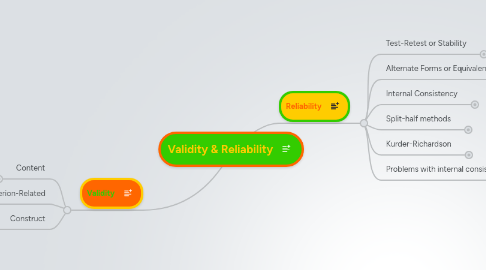
1. Reliability
1.1. Test-Retest or Stability
1.1.1. Reliability are obtained by administering the same test twice to the same group of individuals, with a a small time interval between testing, and correlating the scores.
1.2. Alternate Forms or Equivalence
1.2.1. Are obtained by administering two alternate or equivalent forms of a test to the same group and correlating their scores.
1.3. Internal Consistency
1.3.1. These estimates should be used only when the test measures a single or unitary trait.
1.4. Split-half methods
1.4.1. Divide a test into halves and correlate the halves with one another. Because these correlations are based on half test, the obtained correlations underestimate the reliability of the whole test.
1.5. Kurder-Richardson
1.5.1. Determine the extent ot which the entire test represents a sing fairly consistent measure of a concept.
1.6. Problems with internal consistency
1.6.1. Estimates tend to yield inflated reliability estimates for speeded tests.
2. Validity
2.1. Content
2.1.1. Comparing test items with instructional objectives to see if they match.
2.2. Criterion-Related
2.2.1. Correlating test scores with external standards or criterion to obtain numerical estimate.
2.2.1.1. Concurrent
2.2.1.1.1. Determined by correlating test scores with a criterion measure collected at the same time.
2.2.1.2. Predictive
2.2.1.2.1. Determined by correlating test stores with a creterion measure collected after a period of time has passed.
2.3. Construct
2.3.1. Determined by finding whether test results correspond with scores on other variables as predicted by some rationale or theory.
